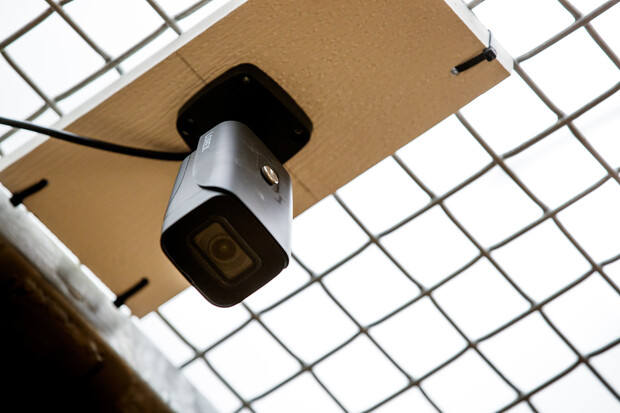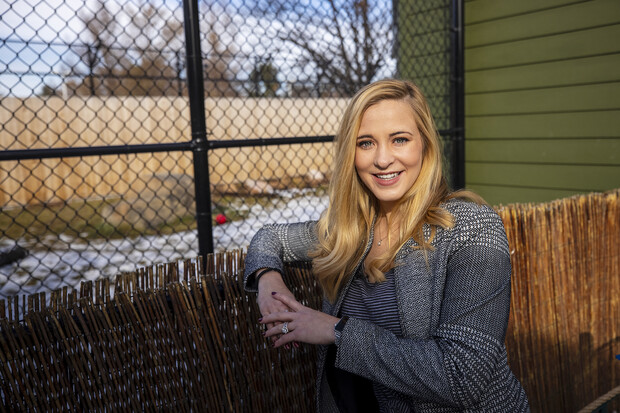Lindsey Amen, January 13, 2021
Husker researchers pilot tracking technology at Lincoln Children’s Zoo
Protecting endangered species is a key mission for zoos across the country — but when those animals become sick or injured, several complications can stand in the way of treating them.
Animals tend to mask their symptoms around humans, making it hard to detect when they’re in pain. Staff also can’t be in enclosures each minute of the day to observe subtle changes in behavior that may set off alarm bells.
Researchers at the University of Nebraska–Lincoln have partnered with the Lincoln Children’s Zoo to pilot video tracking technology that can automatically monitor those behavioral changes, allowing zookeepers to detect injury and illness earlier on. The system is currently being tested on the zoo’s four new female cheetahs.
“We originally developed this tracking system for livestock, specifically cattle and pigs. After having success on that front, we wanted to branch out and see what uses it could have in other animals,” said Ty Schmidt, associate professor of animal science, who is leading the project alongside animal science doctoral student Haley Beer.
“If we can catch an illness before the animal shows clinical symptoms, our antibiotic treatments are more effective, and we have a much higher success rate of getting that animal turned back around.”
To track the cheetahs, six cameras — programmed with deep-learning code developed at the University of Nebraska–Lincoln — assign a special “fingerprint” to each animal based on the shape of their bodies and the pattern of their hide.
The system is capable of measuring a variety of behavioral metrics, including how fast each cheetah walks, the distance it covers per day, and the amount of time it spends eating, lying down and standing.
Data from the cameras will then feed into a spreadsheet for zookeepers to examine. An excess of certain behaviors, such as sleeping, pacing or grooming, can alert staff that something may be wrong.
“Once the machine begins to categorize those behaviors, I will annotate or characterize them to ensure accuracy,” Beer said. “So I’ll look at a frame and say, ‘Yes, this cheetah is laying with its head up, or it’s laying with its head down. It’s sitting, it’s running.’”
“The best thing is, it’s continuous,” Schmidt added. “Once we’ve installed and programmed the system, it can collect 300 to 400 days of data automatically.”

Inspiration for the research came from Beer’s former stint as a zookeeper. The doctoral student worked at the Lincoln Children’s Zoo for two years after undergrad, where she developed a passion for animal conservation.
When it came time to choose a doctoral project last fall, Beer reached out to Trent Shrader, the zoo’s director of medicine, to see if he’d be interested in a partnership with the university.
“I’m really excited, because I never thought I’d be able to take my own experiences or these limitations that I saw as a zookeeper and actually try to find a solution,” Beer said.
“I knew when I was a senior in college that I wanted to do something with wildlife, and I stayed in Lincoln for that fact. I’m really glad I did, just because it’s taken me in more places than I expected.”
Schmidt first started working on the system, also known as NUtrack, with Husker scientists Eric Psota and Benny Mote in 2015. Since then, the team has secured $675,000 in funding to further develop the technology and use it to monitor pigs in a commercial setting.
Seeing their research repurposed in this new way, Schmidt said, has been a rewarding experience.

“I’m incredibly proud of the fact that we’ve been able to create the most advanced, accurate system in the world for tracking individual animals here at Nebraska,” Schmidt said.
Moving forward, the team sees endless possibilities for how the tracking system can be used. Cameras could be installed to monitor outdoor, free-range populations at wildlife preserves, or tested out on other zoo animals.
“There’s just a huge place in conservation for this technology, and I’m really excited to see where it goes,” Beer said.





